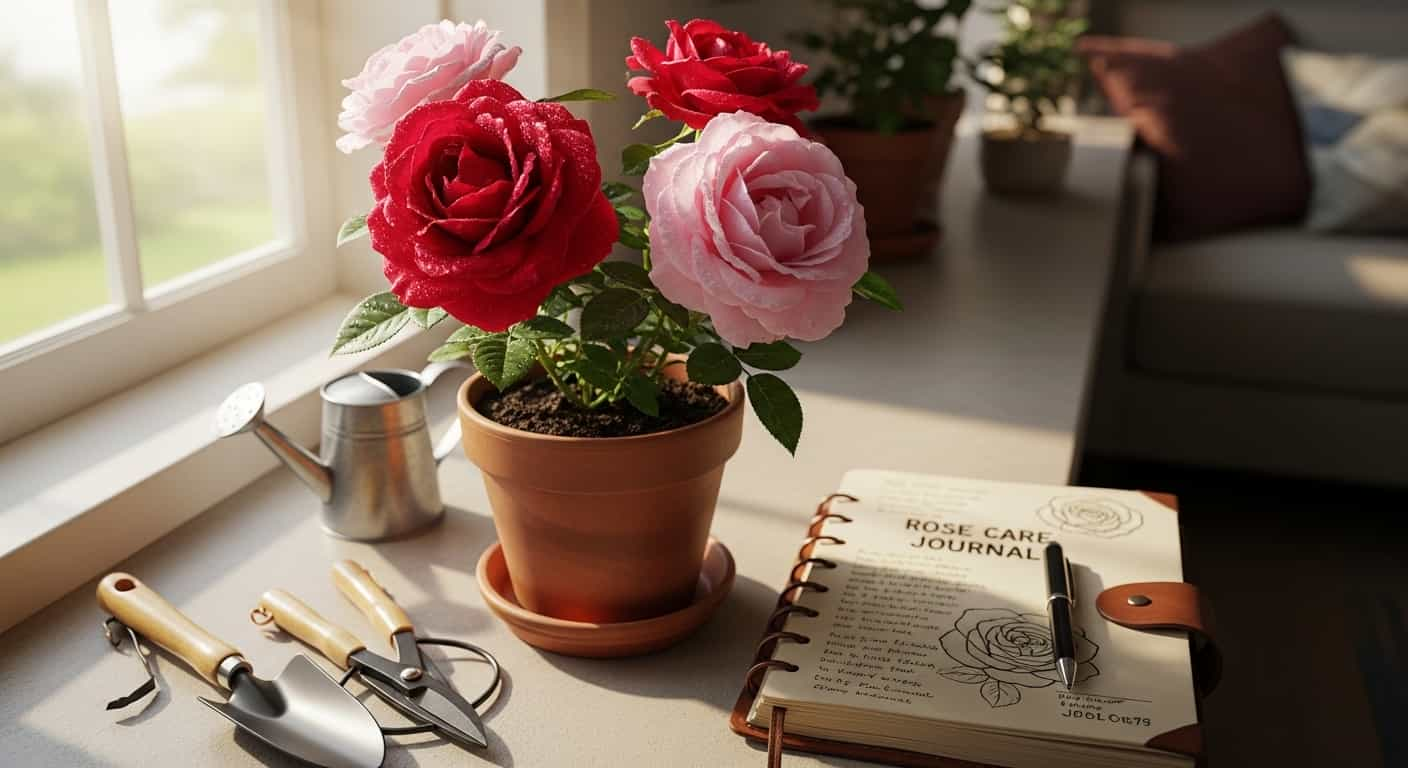Bringing the classic beauty of roses indoors can transform any living space, adding a touch of elegance and a delightful fragrance. While often seen as garden-dwellers, many rose varieties, especially miniature roses, thrive inside with the proper care. Growing roses indoors presents a unique set of challenges compared to cultivating them outside, but the rewards are well worth the effort. With a little knowledge and consistent attention, you can enjoy vibrant blooms year-round.
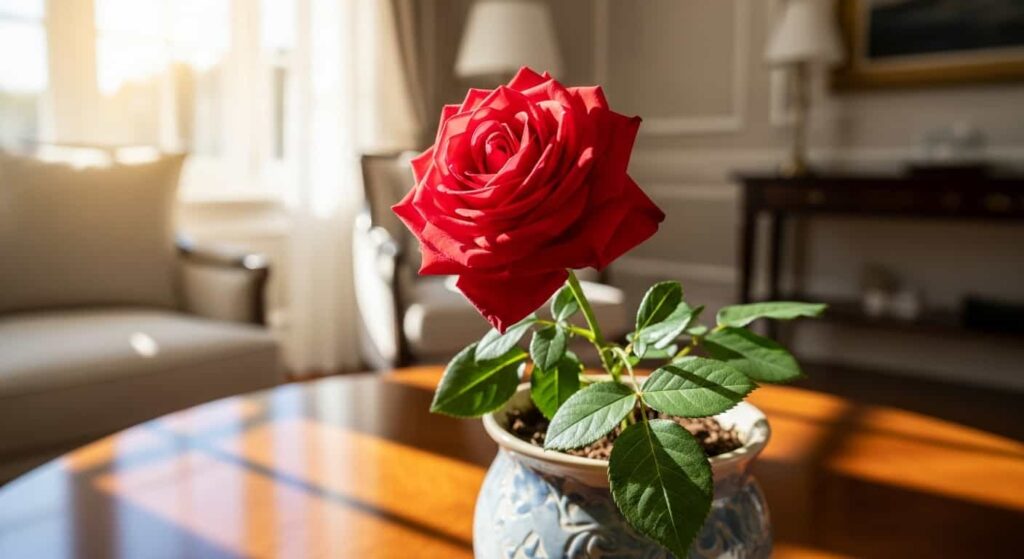
This comprehensive guide will walk you through everything you need to know to become an expert in indoor rose care. We will cover the essential elements of light, water, and soil, along with crucial practices like pruning, feeding, and managing pests. By understanding the specific needs of your indoor roses, you can create the perfect environment for them to flourish, producing beautiful flowers that brighten your home and lift your spirits.
Choosing the Right Roses for Indoor Growing
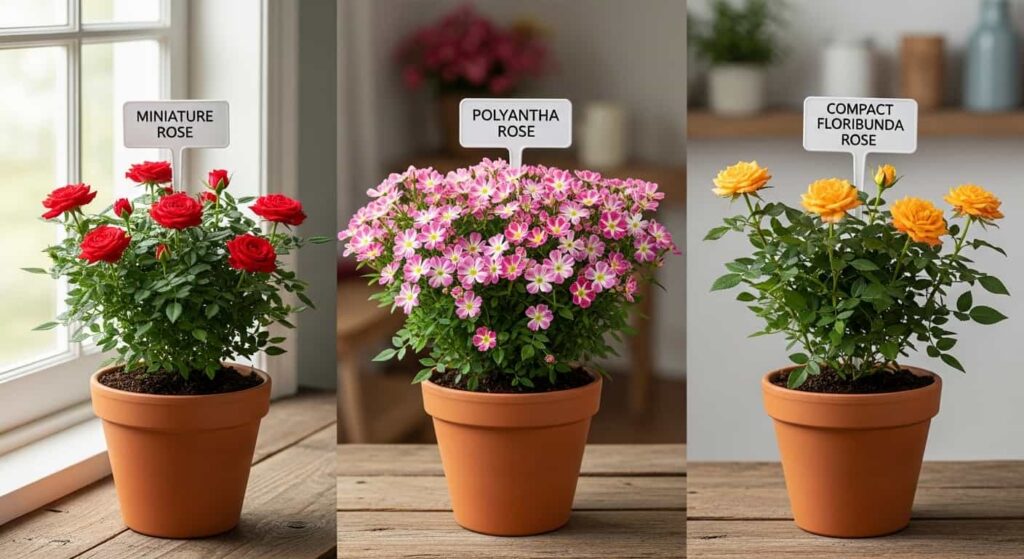
Before we dive into the care specifics, it’s important to start with the right plant. While you can technically try to grow any rose indoors, some varieties are much better suited for container life.
Miniature Roses: These are, by far, the most popular and successful choice for indoor cultivation. They are bred to stay compact, typically growing between 6 to 18 inches tall. Their smaller size makes them manageable for windowsills and tabletops. They come in a wide array of colors and often bloom profusely throughout the year.
Polyantha Roses: Known for their prolific clusters of small blooms, Polyanthas are another good option. They are generally compact, hardy, and repeat-blooming, making them adaptable to indoor conditions.
Smaller Floribunda Roses: Some compact Floribunda varieties can also be grown indoors, offering clusters of classic rose flowers. Look for cultivars specifically noted for their suitability for container growing.
When you purchase a new indoor rose, it often comes in a small, flimsy plastic pot. It’s a good idea to repot it into a slightly larger container with good drainage soon after bringing it home. This gives the roots more room to grow and helps you control the soil and moisture levels more effectively.
The Foundation of Care: Light, Water, and Humidity
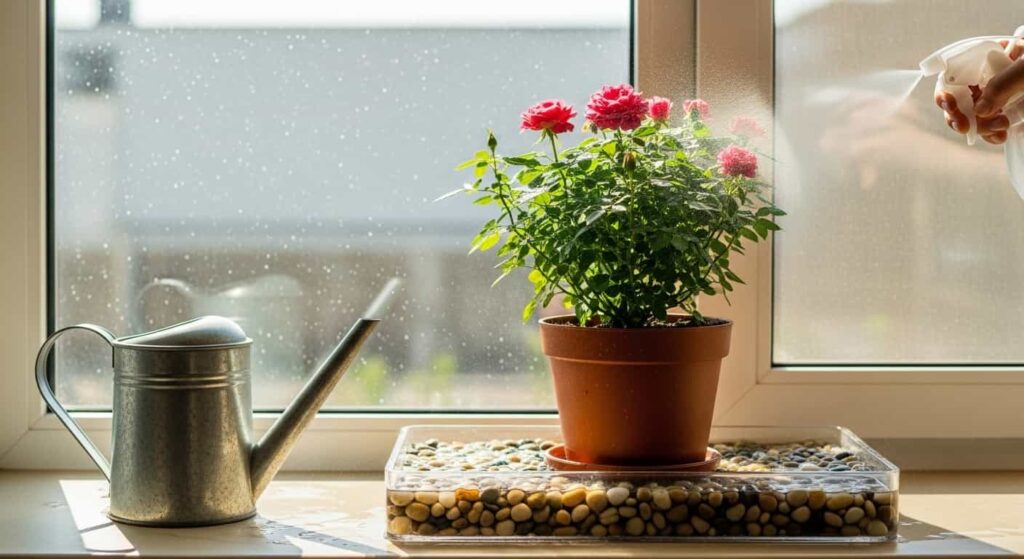
Getting the basic environmental conditions right is the most critical aspect of keeping your indoor roses healthy and blooming.
Light Requirements: A Place in the Sun
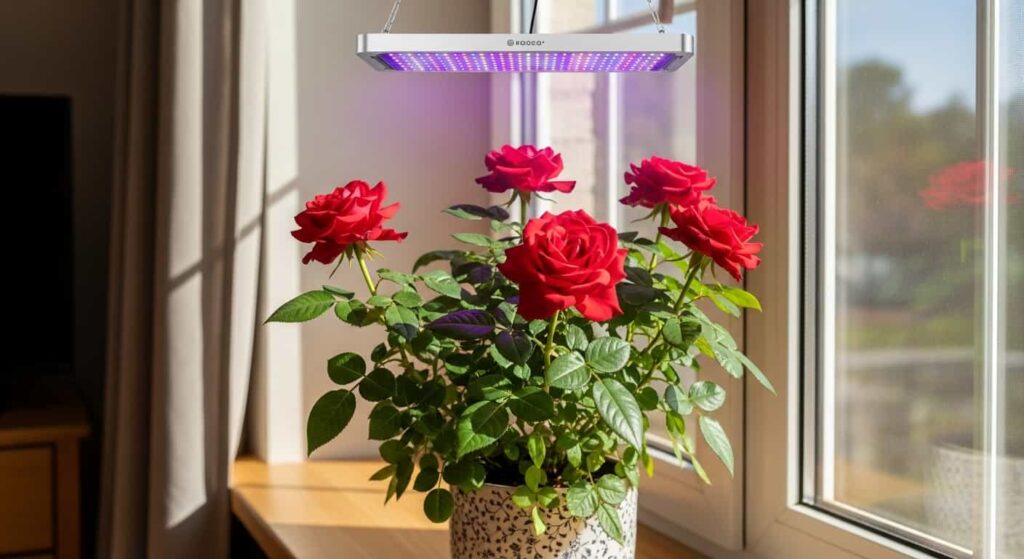
Roses are sun-loving plants, and this doesn’t change when you bring them indoors. Inadequate light is the most common reason indoor roses fail to thrive and bloom.
- Amount of Light: Your indoor rose needs a minimum of six to eight hours of direct sunlight each day. A south-facing or west-facing window is the ideal location. If you see your rose stretching towards the light with long, spindly stems and few leaves, it’s a clear sign it needs more sun.
- Rotating the Plant: To ensure all sides of the plant receive adequate light and to promote even growth, rotate the pot a quarter turn every few days. This prevents the plant from leaning in one direction.
- Supplemental Lighting: If you don’t have a spot that provides enough natural sunlight, especially during the darker winter months, you’ll need to supplement with artificial light. A full-spectrum LED or fluorescent grow light works wonders. Position the light about 12 inches above the plant and keep it on for 12 to 16 hours a day. Using a simple timer can make this process effortless.
Watering: The Delicate Balance of Moisture
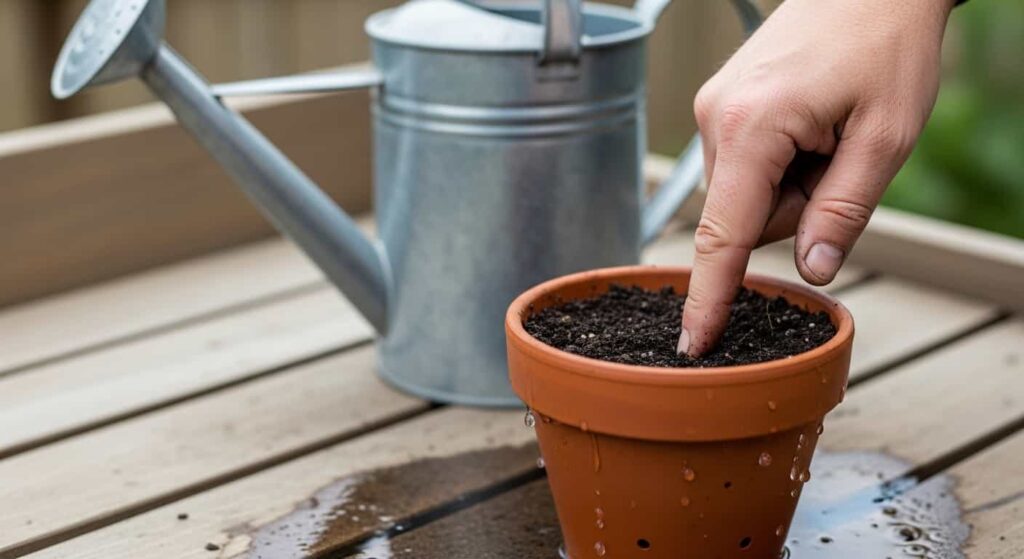
Watering indoor roses requires a careful touch. Both overwatering and underwatering can lead to serious problems like root rot, yellowing leaves, and pest infestations.
- How to Check for Dryness: The best way to know when to water is to check the soil. Insert your finger about an inch deep into the pot. If the soil feels dry at that depth, it’s time to water. Don’t rely on a fixed schedule, as watering needs can change based on the season, temperature, and humidity in your home.
- Watering Technique: When you water, do so thoroughly. Pour water slowly over the soil until it begins to drain from the bottom of the pot. This ensures the entire root ball is saturated. Allow the pot to drain completely, and then discard any excess water from the saucer. Never let your rose sit in a puddle of water, as this is a primary cause of root rot.
- Water Quality: Roses can be sensitive to the chlorine and other chemicals found in tap water. If possible, use filtered, distilled, or rainwater. If you must use tap water, let it sit out overnight to allow some of the chlorine to dissipate.
Humidity: Recreating a Rose-Friendly Atmosphere
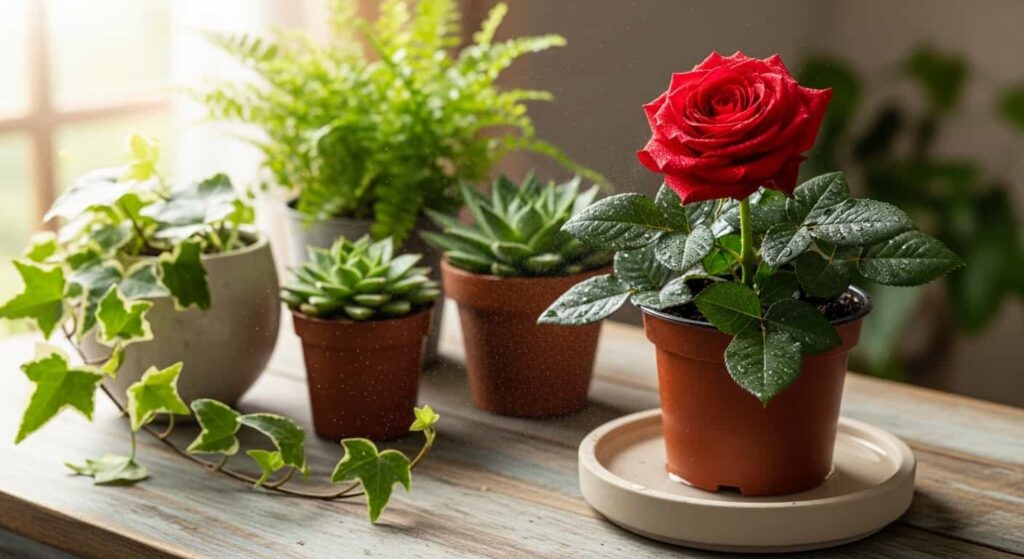
Roses appreciate a humid environment, which can be a challenge in centrally heated or air-conditioned homes. Dry air can cause leaves to brown at the edges and make the plant more susceptible to pests like spider mites.
- Misting: Gently misting your rose with a spray bottle a few times a week can help increase the ambient humidity. It’s best to do this in the morning so the leaves have time to dry before nightfall, which helps prevent fungal diseases.
- Pebble Tray: A more passive way to increase humidity is to use a pebble tray. Fill a shallow tray with a layer of pebbles and add water until it’s just below the top of the stones. Place your potted rose on top of the pebbles. As the water evaporates, it will create a humid microclimate around the plant.
- Grouping Plants: Plants naturally release moisture through a process called transpiration. Grouping your rose with other houseplants can help raise the humidity for all of them.
Soil and Feeding: Nutrients for Beautiful Blooms
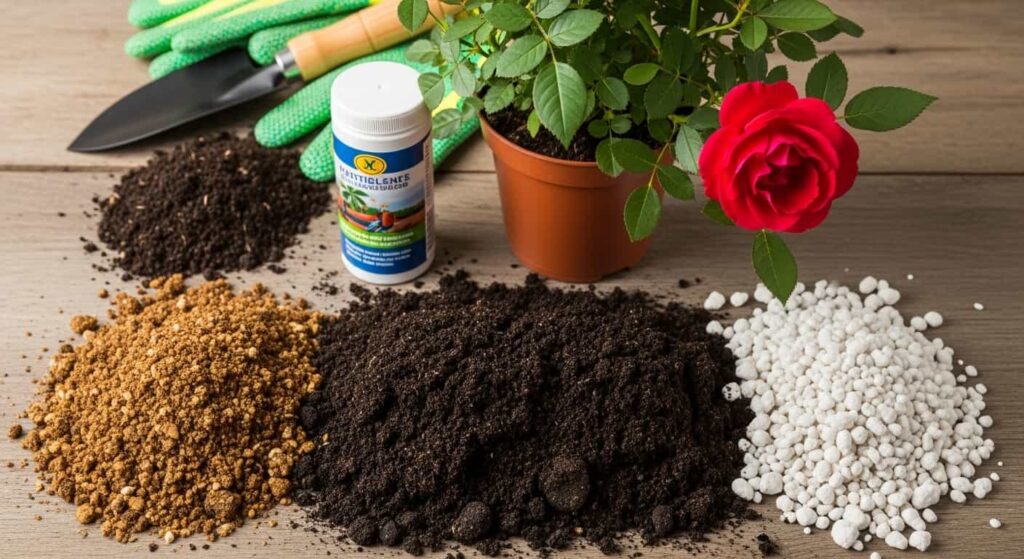
The right soil mix and a consistent feeding schedule are essential for providing the energy your rose needs to produce lush foliage and a steady supply of flowers.
The Perfect Potting Mix
Indoor roses need a potting medium that is both moisture-retentive and well-draining. A standard, all-purpose potting soil is a good starting point, but you can improve it for your roses.
- Ideal Soil Recipe: Create a superior mix by combining one part high-quality potting soil, one part compost or well-rotted manure, and one part perlite or coarse sand. This blend provides rich organic matter for nutrients, retains adequate moisture, and ensures excellent drainage to prevent waterlogged roots.
- Pot Selection: Choose a pot that is at least 6-8 inches in diameter and has multiple drainage holes. Terracotta pots are an excellent choice as they are porous and allow air to reach the roots, helping the soil dry out more evenly.
Fertilizing for Continuous Blooms
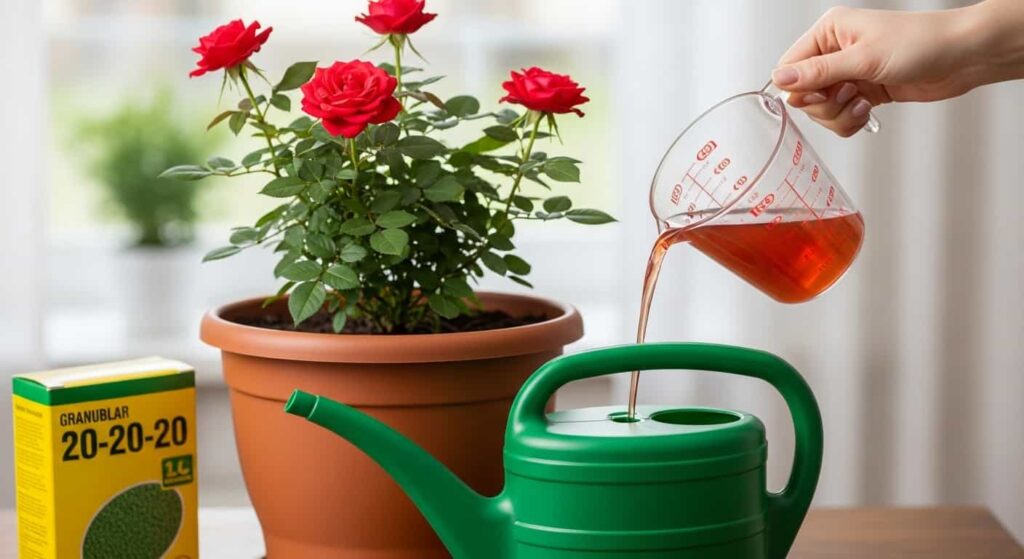
Container-grown plants have limited access to nutrients and rely on you to provide them. Regular feeding is crucial for indoor roses, especially during their active growing and blooming periods.
- Type of Fertilizer: A balanced, water-soluble fertilizer formulated for roses or flowering plants is ideal. Look for one with an NPK ratio like 20-20-20 or a specialized rose formula. You can also use organic options like fish emulsion or a slow-release granular fertilizer.
- Feeding Schedule: During the spring and summer, when the plant is actively growing, fertilize your rose every two to four weeks. Follow the package instructions carefully, as over-fertilizing can burn the roots and damage the plant. It’s often better to fertilize more frequently with a diluted solution than to apply a strong dose infrequently.
- Winter Rest: Reduce feeding in the fall and stop completely during the winter. This allows the plant to enter a natural period of dormancy or rest, which is important for its long-term health.
Pruning and Deadheading: Shaping for Health and Beauty
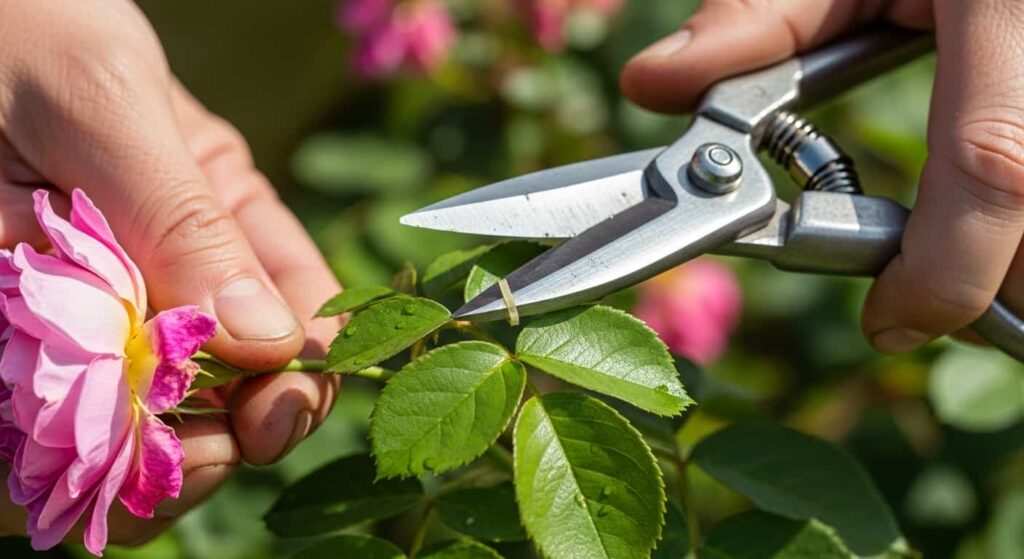
Pruning is not just for outdoor garden roses; it’s a vital task for keeping your indoor roses healthy, well-shaped, and productive.
The Art of Deadheading
Deadheading is the simple act of removing spent or faded flowers. This is one of the most important things you can do to encourage your rose to produce more blooms.
- Why Deadhead? When a flower fades, the plant puts its energy into producing seeds (rose hips). By removing the old bloom, you redirect that energy back into creating new leaves and, most importantly, new flowers.
- How to Deadhead: Follow the stem of the faded flower down to the first leaf with five leaflets. Make a clean cut with sharp pruning shears or scissors just above this leaf, angling the cut at about 45 degrees.
Structural Pruning
Beyond deadheading, your indoor rose will benefit from occasional structural pruning to maintain its shape and promote healthy new growth.
- When to Prune: The best time for a more significant pruning is in the late winter or early spring, just before new growth begins.
- What to Remove:
- Dead or Damaged Canes: Cut out any stems that are dead, broken, or look unhealthy.
- Crossing Branches: Remove any canes that are rubbing against each other. This improves air circulation and prevents wounds that can invite disease.
- Weak, Spindly Growth: Prune away thin, weak stems to encourage the plant to produce stronger, more robust canes.
- Shaping the Plant: Aim to create an open, vase-like shape. This allows light and air to penetrate the center of the plant, which is crucial for preventing fungal diseases like powdery mildew. Don’t be afraid to prune back about one-third of the plant’s overall size to invigorate it.
Common Pests and Diseases: Prevention and Treatment
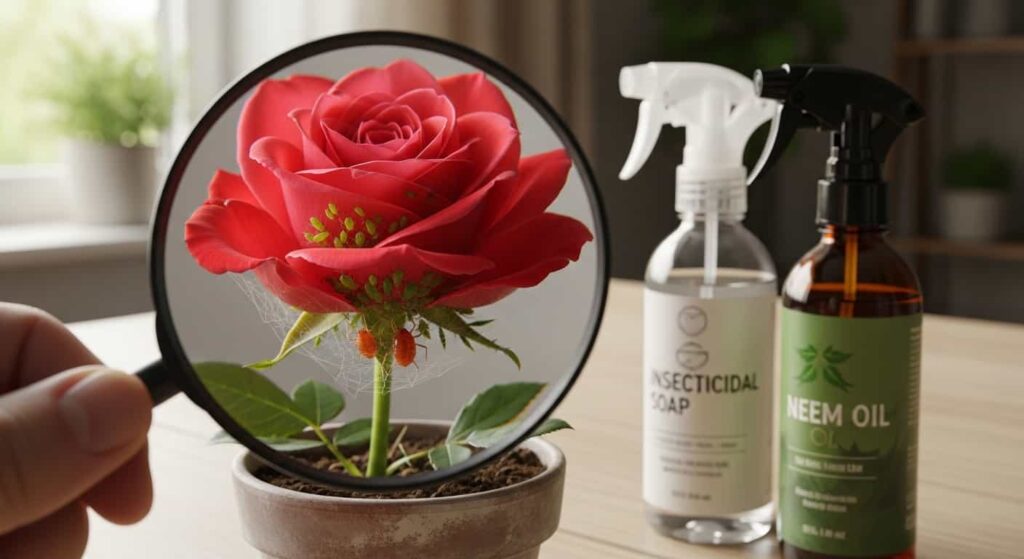
Indoor roses are generally less exposed to pests and diseases than their outdoor counterparts, but they are not immune. Vigilance is your best defense.
Common Pests
- Spider Mites: These are the most common pests on indoor roses. They are tiny and hard to see, but you’ll notice their fine webbing, especially on the undersides of leaves. They thrive in hot, dry conditions.
- Treatment: Increase humidity and regularly wash the plant’s leaves with a strong spray of water. For heavier infestations, use insecticidal soap or horticultural oil, making sure to coat all surfaces of the plant.
- Aphids: These small, soft-bodied insects cluster on new growth and flower buds, sucking the sap from the plant.
- Treatment: A strong jet of water can often dislodge them. You can also wipe them off with a cloth or treat the plant with insecticidal soap.
Common Diseases
- Powdery Mildew: This fungal disease appears as a white, powdery coating on leaves, stems, and buds. It’s common in conditions of poor air circulation and high humidity without sufficient light.
- Treatment: Improve air circulation around your plant. Prune out heavily infected parts. Treat with a fungicide formulated for roses or a homemade remedy of one tablespoon of baking soda mixed with a gallon of water and a few drops of dish soap.
- Black Spot: This is another fungal disease that causes black spots on the leaves, which then turn yellow and drop off.
- Treatment: Remove and destroy infected leaves immediately. Avoid getting the foliage wet when watering. Ensure good air circulation. A copper-based fungicide can be used for persistent cases.
Avoiding Common Mistakes
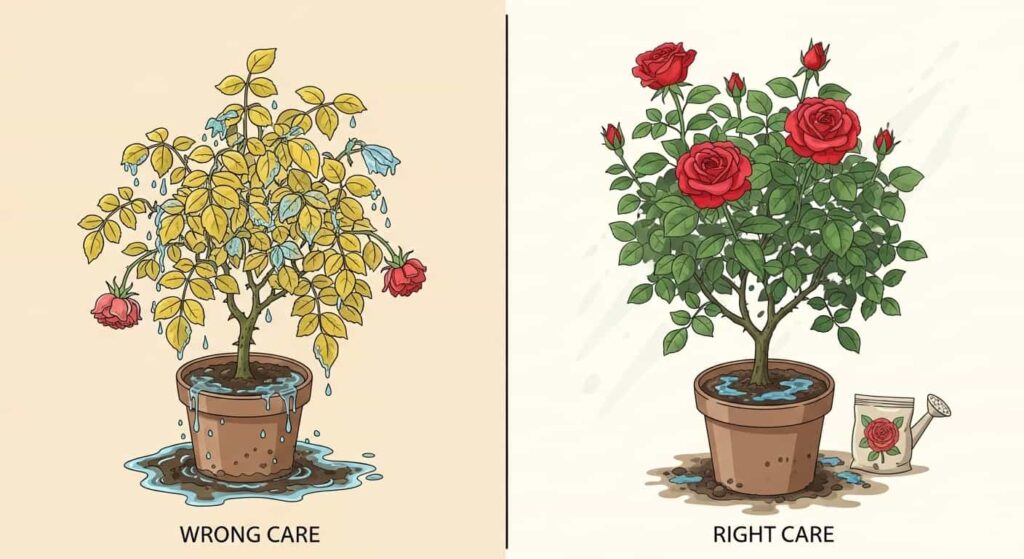
Even with the best intentions, it’s easy to make a few missteps. Here are some common mistakes to avoid:
- Insufficient Light: This is the number one killer of indoor roses. If you don’t have a very sunny window, invest in a grow light.
- Overwatering: Loving your plant too much with water is a frequent problem. Always check the soil before watering and ensure your pot has excellent drainage.
- Ignoring Pests: Small pest problems can quickly become major infestations. Inspect your plant regularly, especially the undersides of leaves, and act at the first sign of trouble.
- Forgetting to Feed: Container roses are heavy feeders. Without regular fertilizing, they won’t have the energy to bloom.
- Skipping Pruning: An unpruned rose will become a tangled, unproductive mess. Regular deadheading and annual pruning are non-negotiable for healthy, blooming plants.
By following this complete care guide, you are well-equipped to grow stunning roses inside your home. It takes a bit of dedication, but the joy of seeing a perfect rose bloom on your windowsill is an unparalleled reward. Pay attention to your plant’s needs, respond to its signals, and you’ll enjoy its timeless beauty for years to come.

